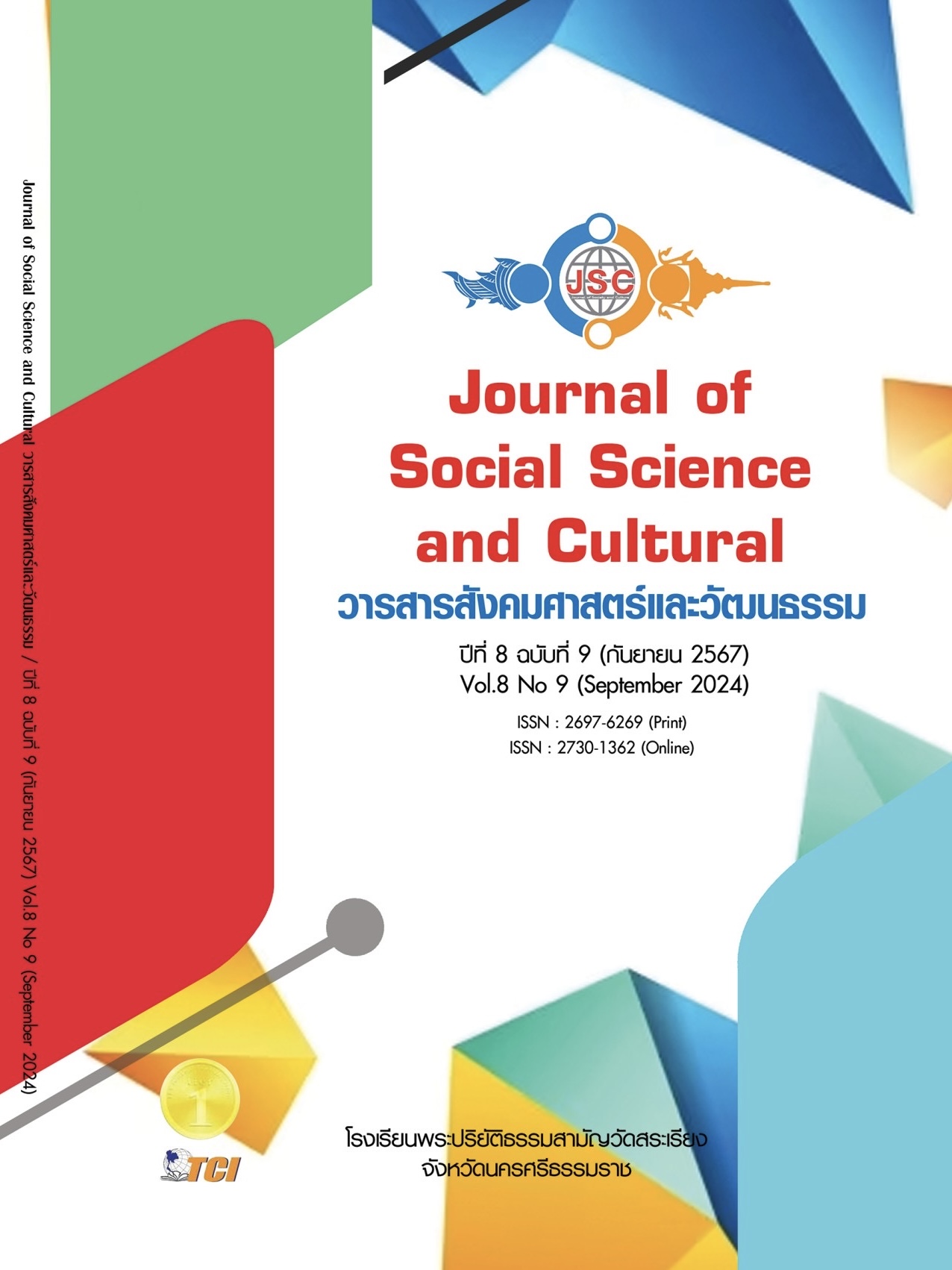COMMUNICATION FOR PARTICIPATION IN THE CIRCULAR ECONOMY USAGE FOR MANAGING MARINE DEBRIS AT LIBONG ISLAND SUB - DISTRICT, TRANG PROVINCE
Main Article Content
Abstract
The objectives of this research were to study communication to build public participation in a circular economy initiative for managing marine waste at Libong Island Sub - district in Trang Province in terms of: 1) context; 2) management; 3) strategies; and 4) approaches for developing better communication. This was qualitative research based on in - depth interviews to collect data from 21 participants. The results showed that 1) context - there was a serious problem with marine waste in the monsoon season. The local residents were aware and understood the problem, but lacked a firm plan and operational guidelines on how to communicate effectively to inform people, change opinions and modify behavior. 2) Management - consisted of planning communication strategies, selecting topics to be communicated that matched the context of the problem, people’s needs, and the people’s way of life. The emphasis was on using existing types of media that were easy to access. Communication mainly used personal media. Evaluation was done on a regular basis to use the results in modifying strategies and tactics. 3) Strategies - build awareness and inform people so they would be conscious of the need to participate in waste management in the correct ways. The strategies aimed to persuade people to follow along and change their behavior. Personal media was used along with the public broadcast system, signs, websites, and online social media to build awareness and modify behavior. There was a strategy of building a network of allies from every sector to join in communications planning, operations and evaluation. 4) Approaches for development – an ad hoc working team should be established to set clearly - defined missions and goals. Role models and influencers should be recruited to help make the communications impactful. Marketing principles should be utilized. The communication evaluation system should be updated to collect more qualitative and quantitative data.
Article Details
References
กมลรัฐ อินทรทัศน์. (2564). หน่วยที่ 3 ยุทธวิธีการสื่อสารเพื่อการพัฒนา ในเอกสารการสอนชุดวิชาการสื่อสารเพื่อการพัฒนา หน่วยที่ 1-7. นนทบุรี: สำนักพิมพ์มหาวิทยาลัยสุโขทัยธรรมาธิราช.
กรมควบคุมมลพิษ. (2566). แผนปฏิบัติการด้านการจัดการขยะพลาสติกระยะที่ 2 (พ.ศ. 2566 - 2570). นนทบุรี: สำนักพิมพ์มหาวิทยาลัยสุโขทัยธรรมาธิราช.
กรมทรัพยากรทางทะเลและชายฝั่ง. (2563). แผนอนุรักษ์พะยูนแห่งชาติ ระยะที่ 1 (พ.ศ. 2563 - 2565). เรียกใช้เมื่อ 17 มีนาคม 2567 จาก https://www.dmcr.go.th/detailLib/4931
กรมอุตสาหกรรมพื้นฐานและการเหมืองแร่. (2564). คู่มือการประเมินประสิทธิภาพการประยุกต์ใช้หลักการเศรษฐกิจหมุนเวียนในองค์กร. เรียกใช้เมื่อ 15 ตุลาคม 2565 จาก http://cepas.dpim.go.th
เจริญเนตร แสงดวงแข. (2558). การสื่อสารคุณค่าของงานความรู้เพื่อการพัฒนาพื้นที่: การใช้สื่อเพื่อการพัฒนาชุมชนตำบลเกาะสาหร่าย จังหวัดสตูล. สงขลา: มหาวิทยาลัยหาดใหญ่.
ชไมกานต์ ดวงแก้ว และอุ่นเรือน เล็กน้อย. (2564). การรับรู้และแนวทางการขับเคลื่อนแนวคิดเศรษฐกิจหมุนเวียน เพื่อการจัดการขยะพลาสติกภายใต้หลัก 3Rs ของเทศบาลนครนนทบุรี. วารสารมหาจุฬานาครทรรศน์, 8(9), 252-265.
ฐิติชญาน์ บุญโสม และคณะ. (2565). การศึกษาแนวทางการจัดการวัสดุรีไซเคิลตามแนวคิดเศรษฐกิจหมุนเวียนในพื้นที่ตำบลเกาะลิบง อำเภอกันตัง จังหวัดตรัง. กรุงเทพมหานคร: องค์การระหว่างประเทศเพื่อการอนุรักษ์ธรรมชาติ (IUCN).
ประชาชาติธุรกิจ. (2562). ไทยชู BCG โมเดล กระตุ้นรัฐ-เอกชนขับเคลื่อนเศรษฐกิจยั่งยืน. เรียกใช้เมื่อ 15 ตุลาคม 2565 จาก https://www.prachachat.net/csr-hr/news-315858
เพชร มโนปวิตร. (2562). ความตายของพะยูน…บอกอะไรกับเรา. เรียกใช้เมื่อ 2 ตุลาคม 2565 จาก https://www.greenpeace.org/thailand/story/8061/marium-the-famous-dugong/.
สรชัด สุจิตต์. (2565). การสื่อสารเพื่อสร้างการมีส่วนร่วมในการจัดการขยะของชุมชนต้นแบบ. ใน ดุษฎีนิพนธ์ปรัชญาดุษฎีบัณฑิต สาขาวิชานวัตกรรมการสื่อสารทางการเมืองและการปกครองท้องถิ่น. มหาวิทยาลัยสุโขทัยธรรมาธิราช.
สายสนิท พงศ์สุวรรณ. (2564). โครงการศึกษาการจัดการขยะมูลฝอยในเกาะลิบง อำเภอกันตัง จังหวัดตรัง. ภูเก็ต: คณะวิทยาศาสตร์และเทคโนโลยี มหาวิทยาลัยราชภัฏภูเก็ต.
สำนักงานนโยบายและแผนทรัพยากรธรรมชาติและสิ่งแวดล้อม. (2547). ความหลากหลายทางชีวภาพในพื้นที่ชุ่มน้ำอุทยานแห่งชาติหาดเจ้าไหม - เขตห้ามล่าสัตว์ป่าหมู่เกาะลิบง - ปากน้ำตรัง จังหวัดตรัง. กรุงเทพมหานคร: เอ็นไวร์ คอนเซ็ป.
สำนักงานเลขานุการของคณะกรรมการยุทธศาสตร์ชาติ. (2561). ยุทธศาสตร์ชาติ พ.ศ. 2561- 2580. กรุงเทพมหานคร: สำนักงานคณะกรรมการพัฒนาการเศรษฐกิจและสังคมแห่งชาติ.
สุรพงษ์ โสธนะเสถียร. (2550). การจัดการทางการสื่อสาร. กรุงเทพมหานคร: สำนักงานกองทุนสนับสนุนการวิจัย.
อภิชัจ พุกสวัสดิ์. (2564). นวัตกรรมการสื่อสารแบบมีส่วนร่วม. กรุงเทพมหานคร: สำนักพิมพ์จุฬาลงกรณ์มหาวิทยาลัย.
อภิชัจ พุกสวัสดิ์ และภาณุฤทธิ์ สารสมบัติ. (2563). การพัฒนานวัตกรรมการสื่อสารแบบมีส่วนร่วมของนักเรียน 30 โรงเรียนมัธยมศึกษาตอนปลายในจังหวัดสมุทรปราการในการจัดกิจกรรมในสถานศึกษา. วารสารการประชาสัมพันธ์และการโฆษณา, 13(2), 1-22.
André, P. B. et al. (2006). Public Participation International Best Practice Principles. from International Association for Impact Assessment. Retrieved July 27, 2021, from https:// www.iaia.org/uploads/pdf/SP4.pdf
ASEAN Secretariat. (2021). Regional Action Plan for Combating Marine Debris in the ASEAN Member. States Jakarta: ASEAN Secretariat.
Kaveri, K. et al. (2020). Waste management communication policy for effective citizen awareness. Journal of Policy Modeling, 42(3), 661-678.
Kollmuss, A. & Agyeman, J. (2002). Mind the Gap: Why Do People Act Environmentally and What Are the Barriers to Pro-Environmental Behavior? Environmental Education Research, 8(1), 239-260.
Lin, X. et al. (2021). Influence of role models on public participation in household waste separation: An examination of local contextualmoderators. Sustainable Production and Consumption, Volume, 27(2021), 1934-1943 .
Mercado, M. (1999). Development Communication Management. The Journal of Development Communication, 12(2), 13-25.
Monika, S. (2015). IT systems supporting waste management in communities - an overview of innovative functions. Management Systems in Production Engineering, 4(20), 210-212.
Prabawati, A. et al. (2023). Strengthening Stakeholder Partnership in Plastics Waste Management Based on Circular Economy Paradigm. Sustainability, 15(5), 1-14.
Tufte, T. & Mefaloputlos, P. (2009). Participatory communication: A practical guide. Washington D.C.: The World Bank.
World Economic Forum. (2016). The New Plastics Economy Rethinking the future of plastics. Retrieved July 2021, 27, from https://www.weforum.org/press/2016/01/more-plastic-than-fish-in-the-ocean-by-2050-report-offers-blueprint-for-change/


